Dental Crowns: Step-by-Step Procedure, Different Types, Cost, Disadvantages

Dental crowns are one of the most common restorative procedures in modern dentistry. Over 15 million Americans have dental crown or bridge replacements for missing teeth, with an annual increase of about 1.7 million cases. These versatile solutions not only restore the functionality of damaged teeth but also enhance their appearance, providing both aesthetic and practical benefits. Dental crowns are often referred to as dental caps due to their function of “capping” or covering a tooth.
Dental crowns address various dental issues, ranging from structural damage due to decay to cosmetic imperfections. They are designed to mimic the look and feel of natural teeth, making them ideal for those seeking both durability and aesthetics. Studies show that dental crowns have a success rate of approximately 94% over five years, underscoring their reliability as long-term dental restorations.
The process of getting a dental crown involves several steps, including dental impressions and the use of dental cement to secure the crown in place. Crowns can be made from various restorative materials, such as casting metal or firing porcelain, offering distinct benefits. In some cases, a dental crown may be part of a larger dental prosthesis or used with a dental implant to replace missing teeth.
This comprehensive guide will delve into the intricacies of dental crowns, including their types, procedures, costs, and potential drawbacks. By the end of this blog, you will have a thorough understanding of dental crowns and be well-equipped to make informed decisions about your dental health.
What is a Dental Crown?
A dental crown, also known as a dental cap, is a dental restoration that completely encases a damaged or decayed tooth. The primary purpose of a dental crown is to restore the tooth’s shape, size, strength, and appearance. Crowns are cemented into place using dental cement and, when properly cared for, can last for many years.

Dental crowns are often recommended to protect the remaining tooth structure after root canal treatment. They are also used in conjunction with dental implants to replace missing teeth. In cosmetic dentistry, crowns can improve the appearance of discolored or misshapen teeth. They play a crucial role in maintaining dental health by supporting weakened teeth and preventing further damage or decay.
Several types of dental crowns are available, each made from different restorative materials, such as casting metal, firing porcelain, or a combination of both. These materials are chosen based on the specific needs and preferences of the patient. For instance, metal crowns are highly durable and ideal for molars, while porcelain crowns offer a natural appearance and are often used for front teeth.
Dental prosthesis, including crowns, are designed to mimic the natural teeth closely. This ensures that they not only function effectively but also blend seamlessly with the rest of the teeth, providing a harmonious and aesthetically pleasing smile.
When Do You Need It?
Dental crowns are recommended in several situations to restore and protect dental health:
- To Protect a Weak Tooth
- After Root Canal Treatment
- To Restore Broken or Worn-Down Teeth
- To Cover and Support a Tooth with a Large Filling
- To Hold a Dental Bridge in Place
- For Cosmetic Enhancement
- To Cover a Dental Implant
Dental Crown Procedure
The dental crown procedure involves several key steps to ensure the crown fits well and functions effectively. Here’s a detailed breakdown of the dental crown procedure:
Preparing a Tooth for a Crown
1. Initial Examination and X-Rays
The process begins with a thorough dental examination. Your dentist will take X-rays to check the roots of the tooth receiving the crown and the surrounding bone. If the tooth has extensive decay or there is a risk of infection or injury to the tooth’s pulp, a root canal treatment may be necessary before proceeding with the crown.

2. Tooth Preparation
Preparing the tooth involves several steps to ensure it can support the crown:
- Retention and Resistance: These are crucial in preparing a tooth for a crown. Retention prevents the crown from dislodging along its insertion path, while resistance prevents dislodgement from oblique forces. Proper tooth preparation ensures a stable base for the crown, allowing it to withstand the forces of chewing. This involves creating parallel or slightly tapered walls and adequate height to maintain the crown securely in place. The aim is to achieve maximum surface area contact between the tooth and the crown, enhancing retention and resistance.
- Taper and Length: The prepared tooth’s taper is critical for the proper fitting of the crown. Ideally, the tooth should have a taper of about 3° to 6° around its circumference. This allows the crown to fit snugly without excessive removal of tooth structure. The length of the prepared tooth is also adjusted to provide sufficient surface area for bonding. Longer teeth offer more retention area, improving the stability of the crown.
- Freedom of Displacement: Freedom of displacement refers to the ability of the prepared tooth to accommodate the crown without displacing adjacent teeth. The preparation must ensure that the crown can fit comfortably within the dental arch, maintaining proper spacing and alignment with neighboring teeth. This involves careful shaping and contouring of the tooth to avoid interference with adjacent teeth.
- Preservation of Tooth Structure: One of the primary goals during tooth preparation is preserving tooth structure. Dentists aim to remove as little tooth material as possible while providing a stable crown foundation. This helps maintain the tooth’s strength and vitality, reducing the fracture risk and preserving its natural function. Techniques such as minimal tapering and selective reduction achieve this balance.
- Structural Durability: Ensuring the structural durability of the crown involves several specific reductions:
- Occlusal Reduction: This refers to reducing the biting surface of the tooth to create space for the crown material without compromising its thickness and strength.
- Functional Cusp Bevel: Shaping the cusps of the tooth to enhance the fit and durability of the crown, ensuring it can withstand chewing forces.
- Axial Reduction: Reducing the vertical height of the tooth to ensure the crown fits properly while maintaining adequate strength and retention.
3. Marginal Integrity
Marginal integrity is critical in ensuring the longevity and functionality of a dental crown. Margins are the edges where the crown meets the tooth. Properly shaped and sealed margins are essential to prevent bacteria from entering and causing decay beneath the crown. Achieving a tight seal involves:
- Precise Tooth Shaping: The edges of the tooth are shaped to create a well-defined, continuous margin that the crown can closely adhere to.
- Smooth Finishing: The prepared margins are smoothened to ensure the crown fits snugly without gaps. This helps prevent plaque and bacteria accumulation at the junction, reducing the risk of decay and gum disease.
4. Gingival Retraction and Dental Impressions
Gingival retraction is a technique used to temporarily move the gum tissue away from the tooth. This step is vital for obtaining accurate impressions:
- Retraction Cord: A small cord is gently placed into the gingival sulcus (the space between the tooth and the gum). This pushes the gum tissue away from the tooth, providing a clear view and access to the entire margin.
- Dental Impressions: Once the gum tissue is retracted, impressions of the prepared tooth and surrounding area are taken. These impressions are used to create a detailed and accurate tooth model, which is essential for crafting a well-fitting crown. Digital scans can also be a modern alternative to traditional putty impressions.
5. Temporary Crown Placement
While waiting for the permanent crown to be fabricated, a temporary crown is placed to protect the prepared tooth:
- Acrylic Material: Temporary crowns are typically made from acrylic, which is durable enough to protect the tooth for a short period.
- Temporary Cement: The temporary crown is attached using temporary dental cement. This allows for easy removal when it’s time to place the permanent crown. The temporary crown helps maintain tooth function and appearance and prevents sensitivity and further damage (Wikipedia) (Wikipedia)
6. Permanent Crown Placement
The final step is the placement of the permanent crown:
- Removing the Temporary Crown: The temporary crown is carefully removed, and the underlying tooth is cleaned to prepare for the permanent crown.
- Checking Fit and Color: The dentist places the permanent crown on the tooth to check for proper fit, alignment, and color match with the surrounding teeth. Adjustments are made as necessary to ensure comfort and functionality.
- Cementing the Crown: Once the fit is confirmed, the crown is permanently cemented onto the tooth. Excess cement is removed, and the crown is polished to ensure a smooth finish. The dentist also checks the patient’s bite to make sure the crown does not interfere with chewing or other teeth.
Types of Dental Crowns
1. 3/4 and 7/8 Crowns
A 3/4 crown covers three-quarters of the tooth’s surface. This typically includes the chewing surface (occlusal) and extends down to cover three of the four sides of the tooth. They are ideal for teeth with significant damage or decay but still have a substantial amount of healthy tooth structure. Covering only part of the tooth, a 3/4 crown conserves more of the natural tooth than a full crown. However, a 7/8 crown covers seven-eighths of the tooth’s surface. This type of crown leaves one of the facial surfaces (often the buccal or outer side) of the tooth uncovered.
Scenarios For Use:
- These crowns are used when one side of the tooth, typically the most visible part, does not need restoration. This approach is particularly useful for molars and premolars, where aesthetics are less of a concern.
- Both these crowns cover a significant portion of the tooth but not the entire surface. They are used when more tooth structure needs to be preserved.
2. Full Metal Crowns
Full metal crowns are dental restorations made entirely of metal. They are known for their strength, durability, and long-lasting performance. Here’s a detailed analysis of the different types of full metal crowns, the materials used, and scenarios when they are used:
High-Noble Alloys:
These alloys contain at least 60% noble metals, with at least 40% being gold. Other noble metals used include platinum and palladium. The remaining composition typically includes base metals like silver or copper to enhance the material’s workability and strength.

Noble Alloys:
These contain at least 25% noble metals. They often include a significant amount of gold, along with platinum, palladium, and other noble metals, but in lower proportions compared to high-noble alloys.
High-noble and noble alloys are highly biocompatible, making them less likely to cause allergic reactions or irritate the gums and surrounding tissues. These metals are resistant to corrosion and tarnish, making them highly durable and long-lasting. Although they are not as aesthetically pleasing as porcelain crowns, the gold or platinum finish can be polished to a high shine, which some patients find attractive.
Scenarios for Use:
- Due to their strength, high-noble and noble alloy crowns are ideal for molars and premolars where the chewing forces are highest.
- These crowns suit patients with sensitivities to base metals, as noble metals are less likely to cause allergic reactions.
Titanium:
Titanium crowns are made from either pure titanium or titanium alloys that may include small amounts of other metals, such as aluminum or vanadium. Titanium is known for its high strength-to-weight ratio, making these crowns extremely durable yet lightweight. It is also highly biocompatible and is often used in medical and dental implants due to its ability to bond well with bone and tissue without causing adverse reactions. Titanium is highly resistant to corrosion from bodily fluids, ensuring the crown’s longevity.
Scenarios for Use:
- Titanium crowns are ideal for patients with allergies to other metals, as titanium is generally well-tolerated.
- They are often used with dental implants due to their excellent integration with bone and tissue.
- Due to their strength and aesthetic neutrality, titanium crowns are suitable for both front and back teeth.
3. Full Ceramic Crowns
Full ceramic crowns are made entirely from ceramic materials, providing excellent aesthetics and biocompatibility. Here’s a detailed analysis of the different types of full ceramic crowns, the materials used, and scenarios when they are used:
Silica-Based Ceramic Crowns

These crowns are primarily composed of silica, known for its translucency and ability to mimic the natural appearance of teeth. Silica-based ceramic crowns offer excellent aesthetics due to their high translucency, making them ideal for front teeth where appearance is crucial. These crowns are generally well-tolerated by the body and are unlikely to cause allergic reactions. While aesthetically pleasing, silica-based ceramics may not be as strong as other ceramic materials and are more prone to chipping or breaking under heavy chewing forces.
Scenarios for Use:
- These crowns are ideal for front teeth, where the primary concern is aesthetics rather than the strength required for molars.
- Suitable for patients who prioritize the natural look of their dental restorations
Alumina-Based Ceramic Crowns
Alumina crowns are made from aluminum oxide, which offers greater strength compared to silica-based ceramics. Alumina crowns are stronger than silica-based crowns, providing better resistance to wear and fracture. While less translucent than silica, alumina crowns still offer good aesthetics suitable for both anterior and posterior teeth. These crowns are highly biocompatible, reducing the risk of adverse reactions.
Scenarios for Use:
- Suitable for both front and back teeth where moderate strength is needed.
- Ideal for patients looking for a balance between durability and aesthetics.
Zirconia-Based Ceramic Crowns
Zirconia crowns are made from zirconium dioxide, known for its exceptional strength and durability. Zirconia crowns are highly durable and resistant to wear and fracture, making them suitable for high-stress areas. These crowns are biocompatible and unlikely to cause allergic reactions or irritation. Modern zirconia crowns can be layered with porcelain to improve their appearance, making them suitable for both anterior and posterior use.
Scenarios for Use:
- It is ideal for molars and premolars due to their strength.
- Suitable for patients who grind their teeth, as zirconia can withstand high chewing forces.
Monolithic Zirconia Crowns
These crowns are made from a single, solid block of zirconia, offering enhanced strength. Monolithic zirconia crowns are extremely strong and durable, suitable for areas with high chewing forces. Like other zirconia crowns, they are highly biocompatible. While not as translucent as other ceramics, their durability makes them an excellent choice for posterior teeth.
Scenarios for Use:
- Ideal for back teeth where strength is more critical than aesthetics.
- Suitable for patients who require crowns that can withstand heavy use.
Lithium-Disilicate Crowns
This material is known for its combination of strength and translucency. Lithium-disilicate crowns offer an excellent balance of strength and natural appearance, making them suitable for both front and back teeth. Highly biocompatible and unlikely to cause adverse reactions. These crowns can be used for various dental restorations, including veneers, inlays, and onlays.
Scenarios for Use:
- Suitable for both front and back teeth due to their strength and appearance.
- Ideal for patients who want strong yet aesthetically pleasing restorations.
4. Metal-Ceramic Crowns (P-F-M Crowns)

Metal-ceramic crowns, also known as porcelain-fused-to-metal (P-F-M) crowns, combine the strength of a metal substructure with the natural appearance of a porcelain exterior. This blend makes them versatile and suitable for both front and back teeth.
The core of a P-F-M crown is made from a metal alloy, which can include high-noble alloys (containing gold or platinum), noble alloys (with a lower percentage of gold or platinum), or base-metal alloys (such as nickel-chromium). The outer layer is made from porcelain, which is fused to the metal substructure at high temperatures. This porcelain layer mimics the natural tooth’s color and translucency. The metal substructure provides a strong foundation that can withstand significant biting and chewing forces, making these crowns durable and long-lasting. The porcelain outer layer is custom-colored to match the surrounding teeth, offering a natural and aesthetically pleasing appearance. This makes P-F-M crowns suitable for visible teeth. While the metal substructure is strong, some patients may experience allergic reactions, particularly to base-metal alloys like nickel. High-noble and noble alloys are generally more biocompatible.
Scenarios for Use:
- P-F-M crowns are used for front teeth where aesthetics are important, thanks to their porcelain exterior.
- The strong metal core makes these crowns suitable for molars and premolars, which endure significant chewing forces.
- These crowns are often used in dental bridges to replace missing teeth due to their strength and durability.
- Ideal for patients needing a combination of strength for functionality and a natural appearance for cosmetic reasons.
Disadvantages and Dangers of Dental Crowns
While dental crowns are highly beneficial, there are some potential disadvantages and risks:
- Sensitivity: Some patients experience sensitivity to hot or cold temperatures after the crown is placed.
- Chipping: Porcelain crowns can sometimes chip, requiring repair or replacement.
- Discomfort or Loose Fit: A newly placed crown might feel uncomfortable or loose if not fitted properly.
- Allergic Reactions: Metal crowns can cause allergic reactions in some patients.
- Decay: If the crown is not properly fitted or if proper oral hygiene is not maintained, decay can occur under
Schedule Your Dental Appointment to Understand More about Dental Crowns
Dental crowns are a versatile and effective solution for restoring damaged teeth, offering both functional and aesthetic benefits. From the initial preparation to the final placement, each step is crucial in ensuring the success and longevity of the crown. Different materials, such as high-noble alloys, base-metal alloys, and ceramics, provide options tailored to individual needs, balancing factors like durability, biocompatibility, and cost.
While crowns have significant advantages, they are not without potential drawbacks. Issues such as tooth sensitivity, the risk of chipping, and possible allergic reactions highlight the importance of careful planning and consultation with a dental professional. Ensuring a precise fit, maintaining excellent oral hygiene, and regular dental check-ups are essential in mitigating these risks.
Understanding the entire process—from when a crown is needed, through the detailed steps of tooth preparation, to the types of crowns available and their respective costs—empowers patients to make informed decisions about their dental health.
We at Dr. Dalesandro guide our patients through the process in a very simple-to-understand manner. We try to make this whole process less daunting and more exciting for our patients. If you have any questions regarding dental crowns, just call us today!


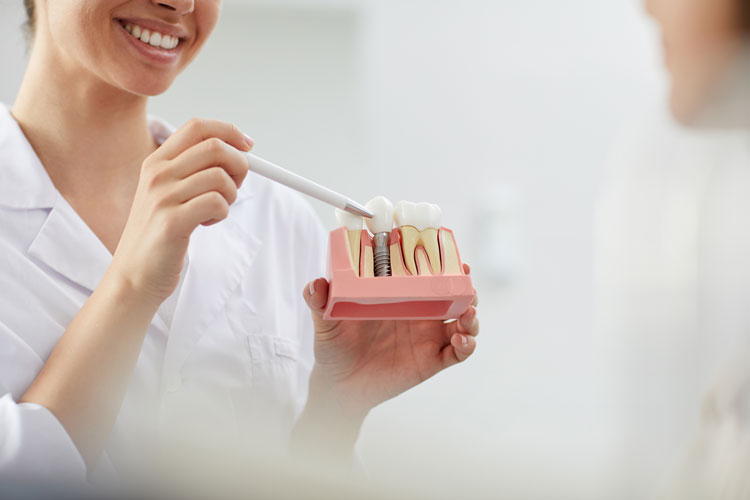

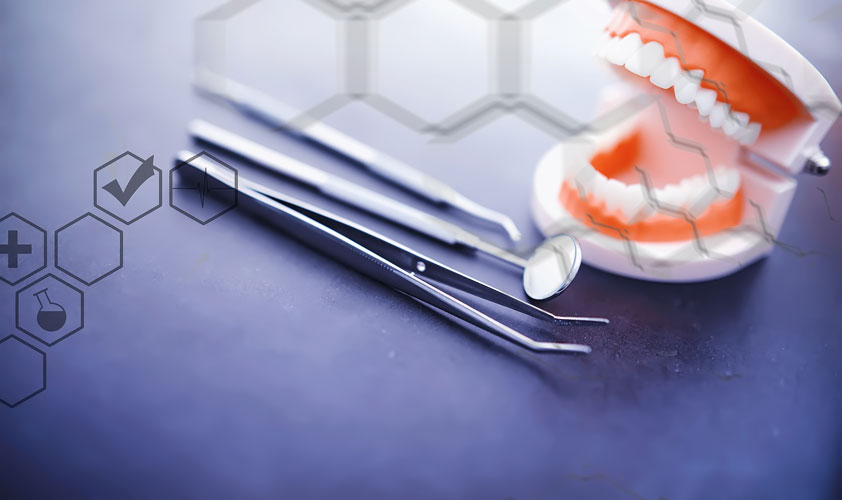
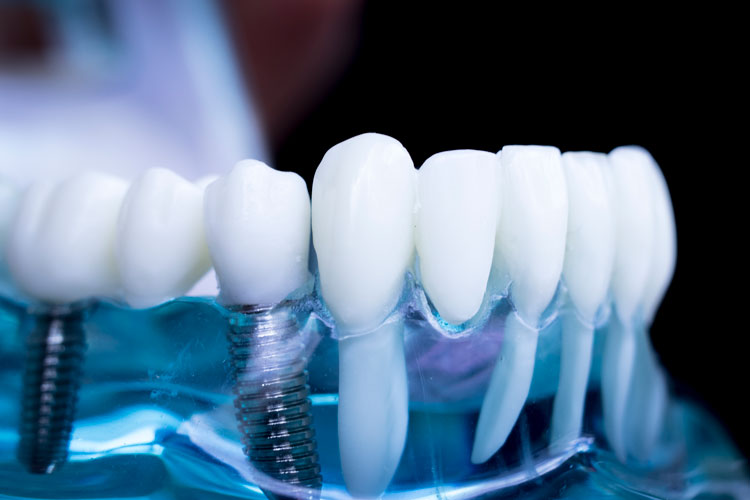



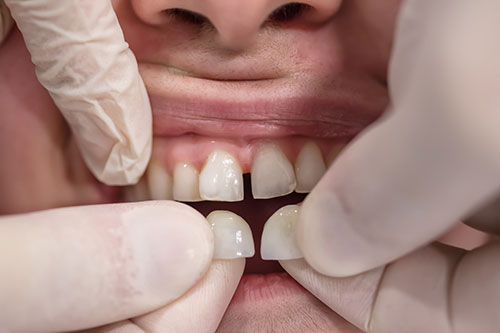 A statistic by the
A statistic by the 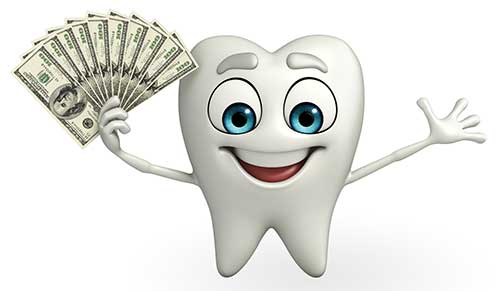 There are quite a few treatments for missing tooth and in
There are quite a few treatments for missing tooth and in  Due to recent technological advancement, a
Due to recent technological advancement, a  Benefits
Benefits Risks
Risks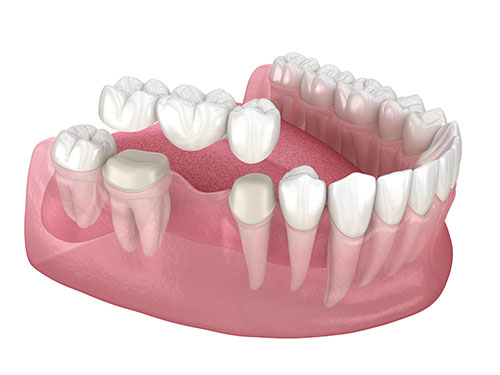 The most common alternative to dental implants is the tooth-supported fixed bridge. Fixed bridges involve grinding the healthy adjacent teeth to attach the bridge. Since the bridge provides just the crowns, the bone beneath may worsen over time. Also, they can last as much as five years before failing.
The most common alternative to dental implants is the tooth-supported fixed bridge. Fixed bridges involve grinding the healthy adjacent teeth to attach the bridge. Since the bridge provides just the crowns, the bone beneath may worsen over time. Also, they can last as much as five years before failing.